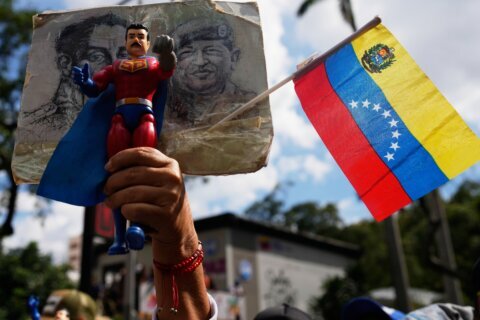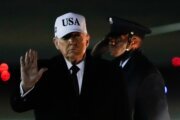In WTOP’s three-part series “The Fog of Espionage,” WTOP national security correspondent J.J. Green delves into what is driving an unprecedented surge in espionage against the U.S., where it’s coming from, what the spies are after, what it’s like to be a spy and what lies ahead.

Daybreak slides westward across the time zones, slowly illuminating the world’s cities, towns and remote villages. The sun burns off the mist of the darkness, bringing a new day into view.
But while daylight often betrays secrets of the night, the activities of a select group of actors remains concealed, protected by sophisticated, hidden organizations and expertly skilled operatives.
Sprinkled among the billions of men and women who rise from slumber and engage in their morning rituals each day are millions of members of a secret fraternity, their true identities and motives unknown even to their immediate families.
They are envoys of espionage — spies. And their No. 1 target is the United States.
They scour the world using tools ranging from high-tech devices to the time-honored tactic of personal interaction, all in relentless pursuit of U.S. government, military and intelligence secrets — and more.
Former Defense Intelligence Agency official Chris Simmons said, “On any given day, 2 to 3 million people worldwide are engaged in espionage.”
Simmons worked in counterintelligence at DIA, where the job was to find and prevent spying against the U.S. He estimated that more than 100 “nations and other interests” are operating in this country.
Robert Baer, who worked covertly for 21 years in the Middle East, Africa, and Central Asia as CIA case officer running spies, believes the number of spies is even greater: “We’re talking about 3 or 4 million.”
Current U.S. government officials, and foreign intelligence officials and diplomats from a half-dozen countries, whom WTOP interviewed on the record and in background discussions, would not affix a number to the pool of active spies they believe are operating in the world. But all determined an alarming and rapidly escalating threat, eclipsing anything they’ve ever experienced, is at work.
Beijing’s spies
Simmons said that of the 2 million to 3 million spies he estimates are active, he thinks about half work for the Chinese government.
Pete Lapp, a special agent at the Washington Field Office of the FBI, said that while he would not discuss numbers of Chinese operatives, “China by far is our preeminent counterintelligence threat.”
Their most sought-after prize, however, extends beyond traditional espionage. Intellectual property from U.S. companies is now a top priority for many spies. “Infiltrating our industries to steal our innovation is a big, big problem.”
FBI director Christopher Wray acknowledged as much in a 2018 speech at the Aspen Security Forum, saying the FBI has economic espionage investigations tracing back to China in all 50 states, covering “everything from corn seeds in Iowa to wind turbines in Massachusetts and everything in between.”

Russian intelligence operatives are widely viewed as more sophisticated — their country has a century-old tradition of dedicated espionage practices and doctrine, dating back to the Cheka in 1918.
But while not as skilled, Chinese spies are considered the most prolific threat because of their sheer number of operatives.
Nicholas Eftimiades, a top Chinese intelligence expert in U.S. intelligence circles, called China’s method “a whole-of-society approach.”
“Not only does it have the structured organizational components like the People Liberation Army and the Ministry of State Security and other entities,” he added, “but the senior leadership in the Central Committee of the Communist Party of China encourages espionage.”
Eftimiades, a retired U.S. intelligence official who now teaches at Penn State, believes the most damaging element about Beijing’s spying efforts is that the targets are not limited to state secrets.
“This,” he said, “is primarily economic espionage, violations of export enforcement regulations and collecting of the type of data that are violations of law in the U.S., but not limited to national security components.”
William Evanina, the director of the National Counterintelligence and Security Center, the main and security adviser to the director of national intelligence, said that the threat is unrivaled.
“When it comes to stealing trade secrets and intellectual property from America, no country poses a greater threat than China,” Evanina said. “America loses an estimated $300 to $500 billion annually to theft of intellectual property by China. It’s the equivalent of every family of four in America losing $4,000 to $6,000 a year,” Evanina said.
He confirms China’s “whole-of-society” approach to espionage.
“While no one objects to a nation engaging in fair competition to advance in world markets, the Chinese government’s tactics are anything but fair. It is pillaging technology and innovation from virtually every sector in America using a broad range of techniques and actors,” Evanina said.
Evolving tactics
China is not the only nation-state or foreign actor that engages in this type of nontraditional espionage.
Their spying methods employ a wide range of tactics, a growing number of which do not involve human contact.
U.S. officials are most concerned about whether the nation has the bandwidth to defend against the threats.
China uses high-volume, nontraditional espionage; Russia employs a diverse, all-of-the-above approach which targets U.S. government secrets, economic data and personal information, while dozens of other adversarial countries and actors are targeting American interests. These are pushing the limits of U.S. defenses, Eftimiades and other experts said.
The problem is compounded by activities by allies of the U.S., who are also allegedly involved in the fray.
On Sept. 12, official Washington erupted into a near-panic after a media report suggested that Sting-Rays — mobile phone surveillance devices — were found near the White House, allegedly planted in an attempt to listen in on President Donald Trump’s mobile phone calls.
The U.S. government concluded that Israel was most likely behind these devices, according to the article, but no proof was provided.
An Israeli Embassy spokesperson flatly denied these allegations. Elad Strohmayer said, “These allegations are absolute nonsense. Israel doesn’t conduct espionage operations in the United States, period.”
A source with knowledge of the situation told WTOP that the leaked information was based on allegations driven by political motivations.
WTOP began investigating reports of suspicious mobile phone surveillance in 2017 and submitted a Freedom of Information Act request to the Department of Homeland Security on April 19, 2018.
Below is DHS’ response on April 24, 2018:
Dear Mr. Green:
This acknowledges receipt of your April 19, 2018, Freedom of Information Act (FOIA) request to U.S. Department of Homeland Security (DHS), National Protection and Programs Directorate (NPPD), for February 6, 2018 DHS National Coordinating Center for Communications (NCC) presentation “XXXXXXX XXXXXX” …
Despite repeated attempts to gain information, only one response, on July 24, 2019, has addressed the request, saying:
Your request is still out for search with the appropriate office. We are backlogged at the moment, and so, many cases are being processed slower than usual. We apologize for the inconvenience and will immediately notify you upon completion of your search.
The response, while an administrative and not a counterintelligence matter, lends credence to the concern that an unprecedented, existential wave of spying in the U.S. is underway. By their own admission, the agency tasked with answering FOIA requests dealing with possible cases of surveillance is wading through a long backlog of requests.
Regardless of the motives and methods of spies inside the U.S. and those working from the outside in, the rising wave of espionage is of enormous concern to U.S. allies, as well, because of the interconnected nature of U.S. intelligence efforts.
In his farewell speech Sept. 4, Duncan Lewis, head of the Australian Security Intelligence Organisation, warned that foreign interference and espionage together create an unprecedented “existential threat.”
Lewis said foreign interference and espionage outrank any other threat facing Australia and, by extension, its Western partners.
“It’s my view that, currently, the issue of espionage and foreign interference is by far and away the most serious issue going forward,” he said.
READ PART 2: A day in the life of an American spy abroad
READ PART 3: A bewildering variety of poisonous snakes








